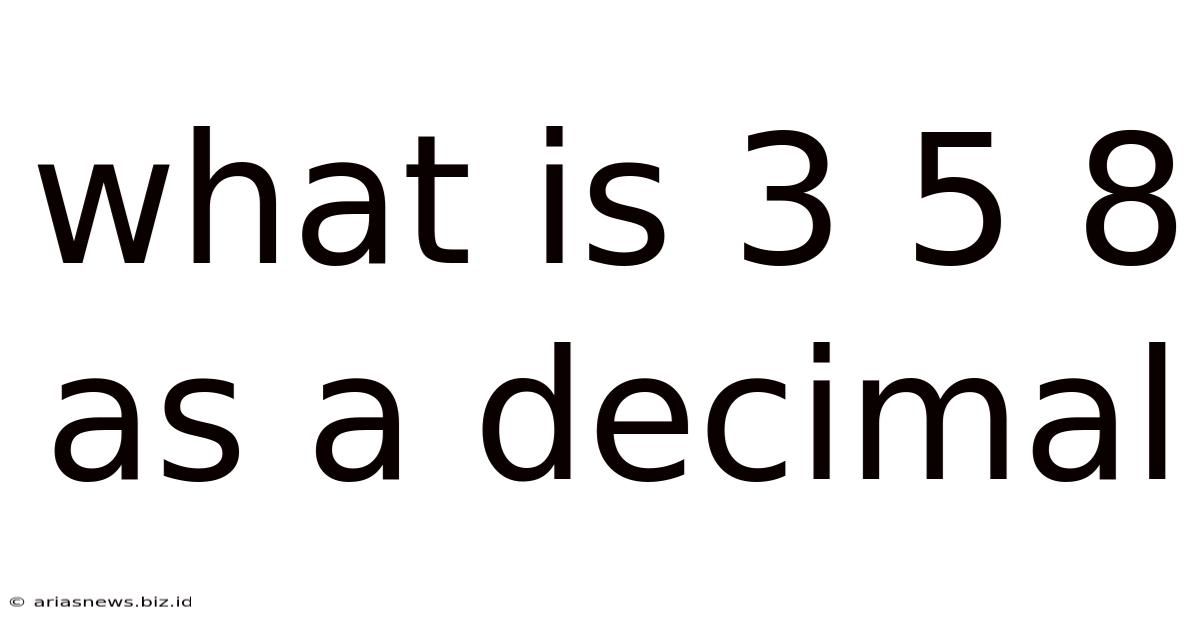What Is 3 5 8 As A Decimal
Arias News
May 12, 2025 · 4 min read

Table of Contents
What is 3 5 8 as a Decimal? A Comprehensive Guide to Converting Mixed Numbers
The seemingly simple question, "What is 3 5/8 as a decimal?", opens a door to a deeper understanding of number systems and their interconversion. This comprehensive guide will not only answer this specific question but also equip you with the knowledge and techniques to convert any mixed number into its decimal equivalent. We'll explore different methods, delve into the underlying concepts, and address common pitfalls. By the end, you'll be confident in handling similar conversions and applying these skills to various mathematical problems.
Understanding Mixed Numbers and Decimals
Before diving into the conversion process, let's briefly review the fundamentals. A mixed number combines a whole number and a proper fraction. In our case, 3 5/8 represents three whole units plus five-eighths of another unit. A decimal, on the other hand, uses a base-ten system to represent numbers using a decimal point to separate whole numbers from fractional parts. Converting between these two forms requires a clear understanding of fractions and their relationship to decimals.
Method 1: Converting the Fraction to a Decimal First
This is arguably the most straightforward method. We'll break down the process into smaller, manageable steps:
Step 1: Focus on the Fraction
The key is to convert the fraction 5/8 into its decimal equivalent. To do this, we perform the division: 5 ÷ 8.
Step 2: Performing the Division
Using long division or a calculator, we find that 5 ÷ 8 = 0.625.
Step 3: Combining with the Whole Number
Now, we simply add the whole number part (3) to the decimal equivalent of the fraction (0.625).
3 + 0.625 = 3.625
Therefore, 3 5/8 as a decimal is 3.625.
Method 2: Converting to an Improper Fraction First
This method involves transforming the mixed number into an improper fraction before converting to a decimal. While slightly longer, it reinforces fundamental fraction manipulation skills.
Step 1: Converting to an Improper Fraction
To convert 3 5/8 to an improper fraction, we follow these steps:
- Multiply the denominator (8) by the whole number (3): 8 x 3 = 24
- Add the numerator (5) to the result: 24 + 5 = 29
- Keep the same denominator (8): This gives us the improper fraction 29/8.
Step 2: Performing the Division
Now, we divide the numerator (29) by the denominator (8): 29 ÷ 8 = 3.625.
This confirms that 3 5/8 is equal to 3.625 in decimal form.
Method 3: Using Decimal Equivalents of Common Fractions
For frequently encountered fractions, it's beneficial to memorize their decimal equivalents. Knowing that 1/8 = 0.125 allows for a quicker calculation:
5/8 = 5 * (1/8) = 5 * 0.125 = 0.625
Again, adding the whole number 3 gives us 3.625.
Understanding the Significance of Decimal Places
The number of decimal places you use depends on the level of precision required. In the case of 3 5/8, the decimal representation terminates at the thousandths place (3.625). However, some fractions result in repeating decimals (e.g., 1/3 = 0.333...). In such cases, you might round to a specific number of decimal places for practical applications.
Applications of Decimal Conversions
The ability to convert mixed numbers to decimals is crucial in many fields, including:
- Engineering and Science: Precise measurements and calculations often require decimal representations.
- Finance: Dealing with monetary values and interest rates necessitates converting fractions to decimals.
- Computer Programming: Many programming languages use decimal representations for numerical data.
- Everyday Life: Calculating proportions, discounts, or splitting bills often involves decimal arithmetic.
Troubleshooting Common Errors
- Incorrect Division: Double-check your division calculations to avoid errors. Use a calculator if necessary.
- Mixing up Numerator and Denominator: Remember the numerator is the top number, and the denominator is the bottom number in a fraction.
- Forgetting the Whole Number: Don't forget to add the whole number back after converting the fraction to a decimal.
Expanding Your Knowledge: Converting Other Mixed Numbers
The methods outlined above can be applied to any mixed number. For example, let's convert 2 3/4 to a decimal:
- Method 1: 3/4 = 0.75; 2 + 0.75 = 2.75
- Method 2: 2 3/4 = 11/4; 11 ÷ 4 = 2.75
Therefore, 2 3/4 is equal to 2.75.
Conclusion: Mastering Mixed Number to Decimal Conversions
Converting mixed numbers to decimals is a fundamental skill with wide-ranging applications. By understanding the different methods and practicing regularly, you can confidently navigate this essential mathematical process. Remember to break down the problem into smaller steps, double-check your calculations, and choose the method that best suits your understanding and the specific problem at hand. With consistent practice, these conversions will become second nature, further enhancing your mathematical proficiency. The seemingly simple question of "What is 3 5/8 as a decimal?" ultimately serves as a gateway to understanding a broader range of mathematical concepts and their practical applications in the real world. Mastering this conversion not only provides the answer to this specific question but equips you with a tool that will be useful across various academic and professional domains.
Latest Posts
Latest Posts
-
Why Is There No Windows In A Jehovah Witness Church
May 12, 2025
-
What Are The Common Factors Of 54 And 72
May 12, 2025
-
How Much Is 33 Celsius In Fahrenheit
May 12, 2025
-
The Distance Around A Figure Is The
May 12, 2025
-
How Do You Say A Pencil In Spanish
May 12, 2025
Related Post
Thank you for visiting our website which covers about What Is 3 5 8 As A Decimal . We hope the information provided has been useful to you. Feel free to contact us if you have any questions or need further assistance. See you next time and don't miss to bookmark.